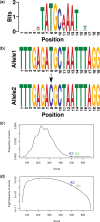is-rSNP: a novel technique for in silico regulatory SNP detection
- PMID: 20823317
- PMCID: PMC2935445
- DOI: 10.1093/bioinformatics/btq378
is-rSNP: a novel technique for in silico regulatory SNP detection
Abstract
Motivation: Determining the functional impact of non-coding disease-associated single nucleotide polymorphisms (SNPs) identified by genome-wide association studies (GWAS) is challenging. Many of these SNPs are likely to be regulatory SNPs (rSNPs): variations which affect the ability of a transcription factor (TF) to bind to DNA. However, experimental procedures for identifying rSNPs are expensive and labour intensive. Therefore, in silico methods are required for rSNP prediction. By scoring two alleles with a TF position weight matrix (PWM), it can be determined which SNPs are likely rSNPs. However, predictions in this manner are noisy and no method exists that determines the statistical significance of a nucleotide variation on a PWM score.
Results: We have designed an algorithm for in silico rSNP detection called is-rSNP. We employ novel convolution methods to determine the complete distributions of PWM scores and ratios between allele scores, facilitating assignment of statistical significance to rSNP effects. We have tested our method on 41 experimentally verified rSNPs, correctly predicting the disrupted TF in 28 cases. We also analysed 146 disease-associated SNPs with no known functional impact in an attempt to identify candidate rSNPs. Of the 11 significantly predicted disrupted TFs, 9 had previous evidence of being associated with the disease in the literature. These results demonstrate that is-rSNP is suitable for high-throughput screening of SNPs for potential regulatory function. This is a useful and important tool in the interpretation of GWAS.
Availability: is-rSNP software is available for use at: www.genomics.csse.unimelb.edu.au/is-rSNP.
Figures


Similar articles
-
atSNP: transcription factor binding affinity testing for regulatory SNP detection.Bioinformatics. 2015 Oct 15;31(20):3353-5. doi: 10.1093/bioinformatics/btv328. Epub 2015 Jun 18. Bioinformatics. 2015. PMID: 26092860 Free PMC article.
-
Large-scale computational identification of regulatory SNPs with rSNP-MAPPER.BMC Genomics. 2012 Jun 18;13 Suppl 4(Suppl 4):S7. doi: 10.1186/1471-2164-13-S4-S7. BMC Genomics. 2012. PMID: 22759655 Free PMC article.
-
CERENKOV2: improved detection of functional noncoding SNPs using data-space geometric features.BMC Bioinformatics. 2019 Feb 6;20(1):63. doi: 10.1186/s12859-019-2637-4. BMC Bioinformatics. 2019. PMID: 30727967 Free PMC article.
-
Discovery and verification of functional single nucleotide polymorphisms in regulatory genomic regions: current and developing technologies.Mutat Res. 2008 Jul-Aug;659(1-2):147-57. doi: 10.1016/j.mrrev.2008.05.001. Epub 2008 May 4. Mutat Res. 2008. PMID: 18565787 Free PMC article. Review.
-
rSNP_Guide: an integrated database-tools system for studying SNPs and site-directed mutations in transcription factor binding sites.Hum Mutat. 2002 Oct;20(4):239-48. doi: 10.1002/humu.10116. Hum Mutat. 2002. PMID: 12325018 Review.
Cited by
-
Searching for new genetic variations in expression databases for the GABAergic and glutamatergic systems.J Mol Neurosci. 2012 Sep;48(1):257-64. doi: 10.1007/s12031-012-9771-z. Epub 2012 Apr 22. J Mol Neurosci. 2012. PMID: 22528461
-
DNA Motif Recognition Modeling from Protein Sequences.iScience. 2018 Sep 28;7:198-211. doi: 10.1016/j.isci.2018.09.003. Epub 2018 Sep 10. iScience. 2018. PMID: 30267681 Free PMC article.
-
rSNPBase: a database for curated regulatory SNPs.Nucleic Acids Res. 2014 Jan;42(Database issue):D1033-9. doi: 10.1093/nar/gkt1167. Epub 2013 Nov 26. Nucleic Acids Res. 2014. PMID: 24285297 Free PMC article.
-
Integrating ChIP-seq with other functional genomics data.Brief Funct Genomics. 2018 Mar 1;17(2):104-115. doi: 10.1093/bfgp/ely002. Brief Funct Genomics. 2018. PMID: 29579165 Free PMC article. Review.
-
Non-coding single nucleotide variants affecting estrogen receptor binding and activity.Genome Med. 2016 Dec 13;8(1):128. doi: 10.1186/s13073-016-0382-0. Genome Med. 2016. PMID: 27964748 Free PMC article.
References
-
- Benjamini Y, Hochberg Y. Controlling the false discovery rate: a practical and powerful approach to multiple testing. J. R. Stat. Soc. Ser. B (Methodol.) 1995;57:289–300.
-
- Claverie J, Audic S. The statistical significance of nucleotide position-weight matrix matches. Bioinformatics. 1996;12:431. - PubMed
-
- Demars JD, et al. Analysis of the IGF2/H19 imprinting control region uncovers new genetic defects, including mutations of OCT-binding sequences, in patients with 11p15 fetal growth disorders. Hum. Mol. Genet. 2010;19:803–814. - PubMed
Publication types
MeSH terms
Substances
LinkOut - more resources
Full Text Sources
Other Literature Sources
Miscellaneous

